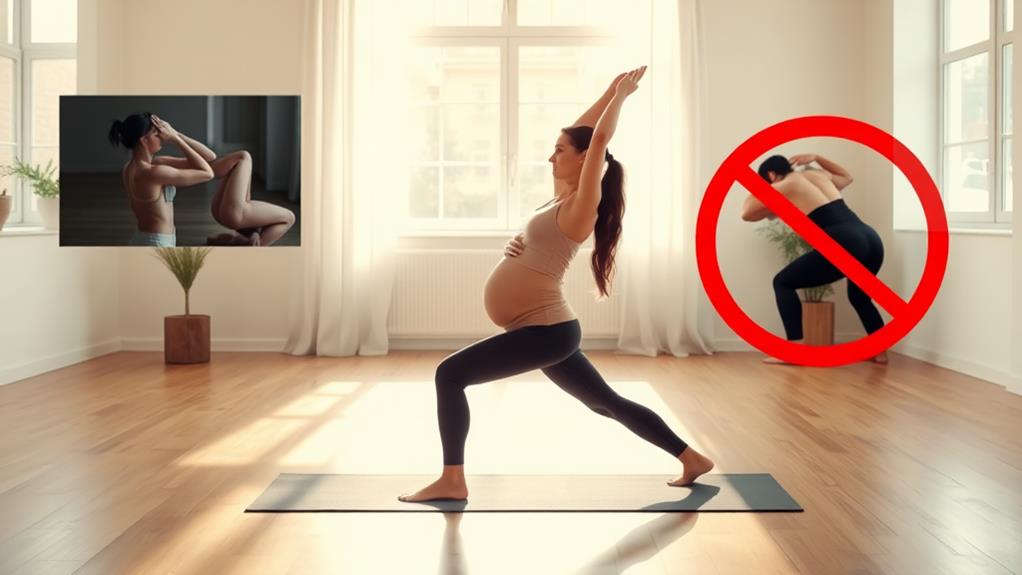When you're pregnant, maintaining a safe yoga practice is essential for both your well-being and that of your baby. There are specific poses that can create unnecessary risks, such as deep twists and full inversions, which may lead to discomfort or imbalance. Understanding which poses to avoid allows you to focus on gentle alternatives that support your body during this transformative time. But what are the key poses you should steer clear of, and how can you adjust your practice to stay strong and safe? Let's explore these important considerations together.
Deep Twists
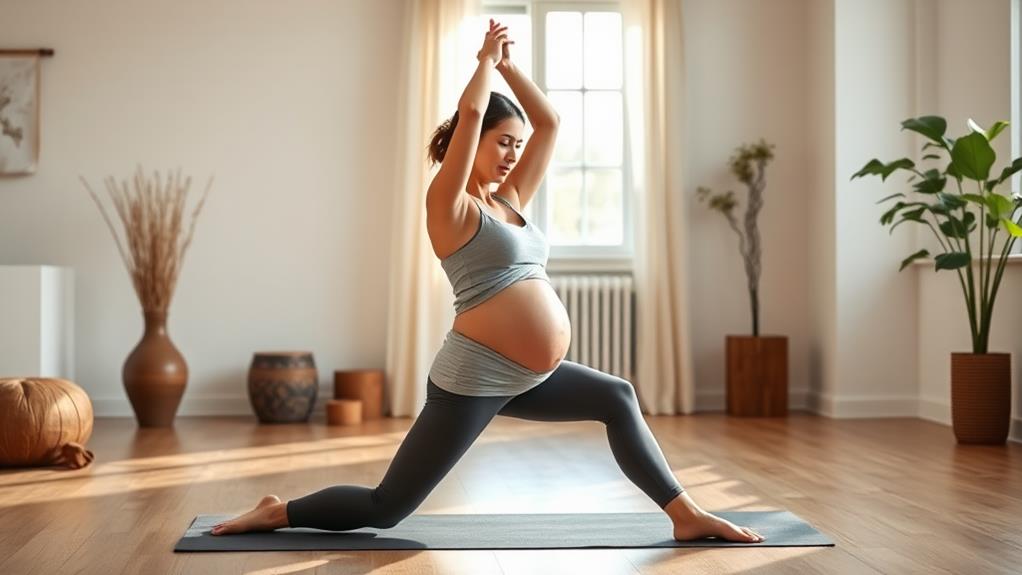
When practicing yoga during pregnancy, it's crucial to steer clear of deep twists. Poses like Revolved Side Angle Pose can compress your abdomen, limiting space for your growing baby. After the first trimester, these deep twists can become unsafe.
Plus, with all those hormonal changes, your ligaments are more lax, which means you're at a greater risk of overstretching or injury.
As your belly grows, your center of gravity shifts, making deep twists uncomfortable and even unstable. Instead of pushing your body into tight positions, listen to what it's telling you.
You'll want to avoid compressing your abdominal muscles and focus on gentle, open twists that allow for spinal mobility without putting pressure on your belly.
Open twists can feel refreshing and help you maintain that lovely connection with your body. Think of it as giving your spine a little dance party instead of a wrestling match.
Full Inversions
Deep twists aren't the only poses to be cautious about during pregnancy; full inversions also carry significant risks. Poses like headstands and handstands should be avoided during pregnancy because they can throw off your balance. As your belly grows, your center of gravity shifts, making falls more likely.
Plus, full inversions can lead to dizziness and discomfort. Nobody wants to feel woozy when they're trying to relax!
Another concern is the pressure these poses put on your abdomen. This pressure can restrict blood flow and oxygen to your baby, which is definitely not something you want. Instead, focus on maintaining stability and comfort. Safe alternatives like downward-facing dog or child's pose can help you stretch without compromising safety.
If you're unsure about what to do, working with a qualified prenatal yoga instructor can be super helpful. They can guide you on safe practices and modifications, ensuring that you and your little one stay safe and strong.
Belly-Down Poses
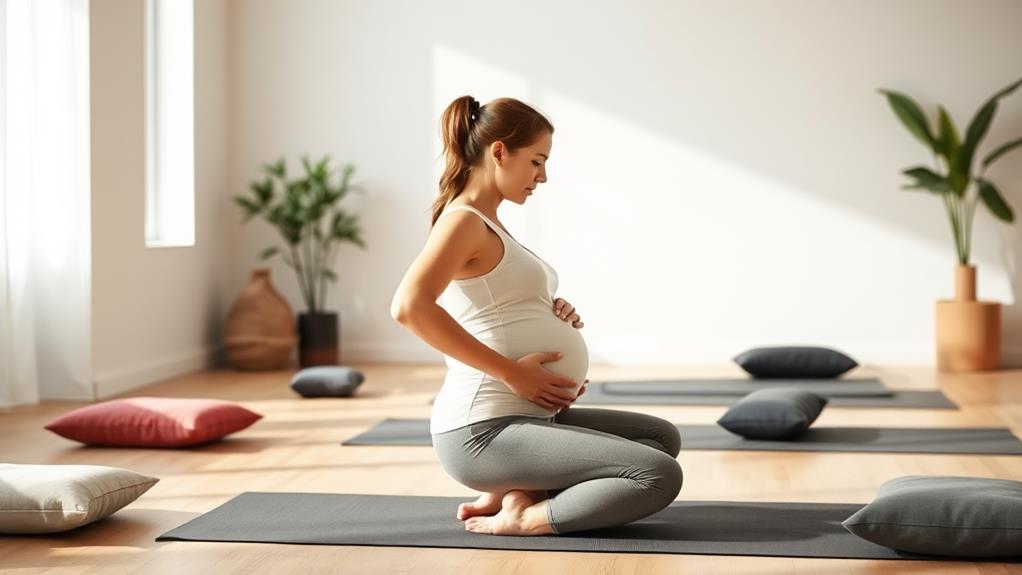
Belly-down poses, like Bow Pose and Locust Pose, can pose significant risks during pregnancy. As your belly grows, these poses increase abdominal pressure, which can be uncomfortable and even lead to lower back pain.
Nobody wants to deal with that, right? Plus, they can contribute to diastasis recti, a condition where your abdominal muscles separate. That's why it's best to steer clear of belly-down poses after the first trimester.
Instead of risking discomfort or injury, why not try some heart-opening poses? Camel Pose is a fantastic option that can give you similar benefits without the belly-down strain.
It opens your heart and helps with gentle stretching, allowing you to feel relaxed and strong.
Supine Positions
Supine positions, particularly lying flat on your back, can become problematic during pregnancy, especially after the first trimester.
While it might seem comfortable at first, spending too much time in these poses can lead to back pain and reduced blood flow to your baby. Yikes! You really wanna avoid anything that might make you feel dizzy or uncomfortable.
Instead of lying flat, you can transition to side-lying positions, which are much safer and more comfortable.
You could prop yourself up with cushions or pillows to keep your upper body elevated. This way, you're still getting the benefits of relaxation without the risks.
Always remember, it's super important to check in with your healthcare provider or a certified prenatal yoga instructor before trying any supine poses.
They can guide you on what's best for your body and your baby.
Forward Folds
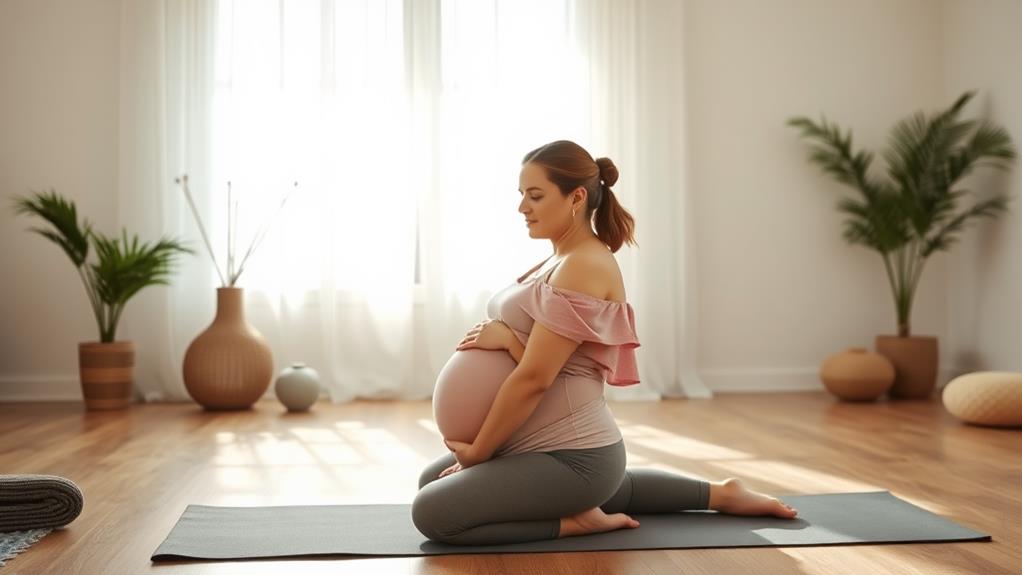
When it comes to forward folds during pregnancy, caution is key. You might love the stretch of a deep forward bend, but as your belly grows, it can lead to discomfort. Full forward folds, like Paschimottanasana (Seated Forward Bend), can compress your abdomen, which isn't great for you or your baby.
Plus, deep forward bends can strain your lower back and pelvic area, increasing your risk of injury.
But don't worry! There are modifications you can try. Using props like a chair or blocks can help you safely enjoy those gentle forward bends. These modifications allow you to keep practicing without putting too much pressure on your abdomen.
It's all about finding what feels good and safe for you.
Remember to limit the duration and intensity of your forward folds. You want to feel good, not strained! So, listen to your body, and if something doesn't feel right, it's totally okay to skip it.
Yoga should be a time to relax and connect, not to push your limits. Stay safe, and keep your practice enjoyable!
Intense Backbends
While backbends can be invigorating, intense variations like Full Wheel Pose (Chakrasana) are best avoided during pregnancy. These poses can strain your abdominal cavity and spine, leading to discomfort or injury you definitely don't want.
As your body changes, you might already feel some lower back pain, and intense backbends can make that worse. Another concern is diastasis recti, a condition where your abdominal muscles separate. Deep backbends can increase this risk, especially as your pregnancy progresses.
Instead, consider practicing gentle backbends or heart-opening stretches like Camel Pose (Ustrasana). They can offer a nice stretch without putting you at risk.
Always chat with a qualified prenatal yoga instructor before trying any backbends. They can help you modify poses to keep you safe while you practice.
Balancing Poses
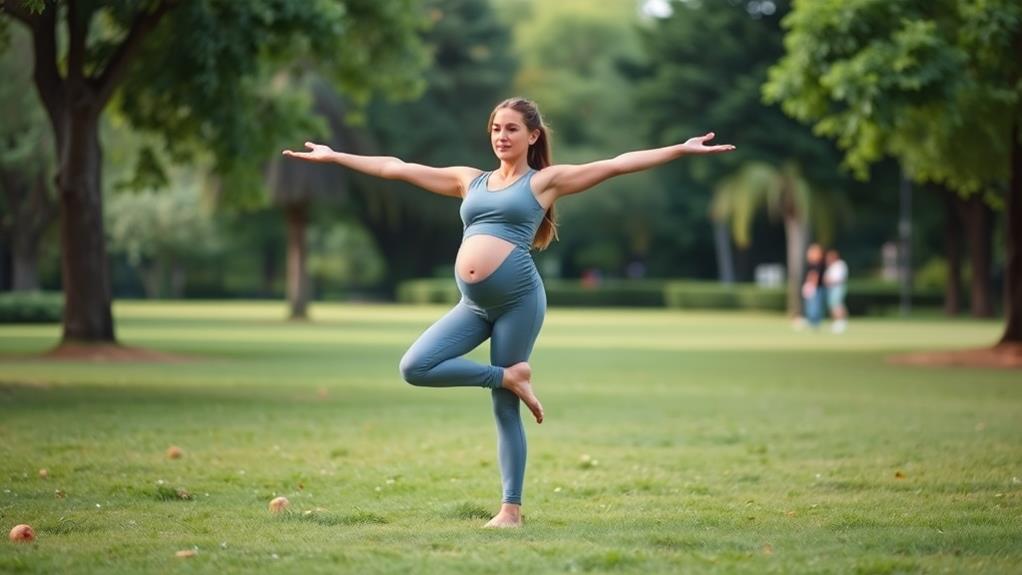
As your body adapts to the changes of pregnancy, balancing poses can pose their own challenges. Poses like Half Moon and Warrior III might seem great, but they can increase the risk of falls.
With your center of gravity shifting, it's crucial to prioritize safety. So, if you want to try balancing poses, consider using props for support, like a wall or a chair. They can really help keep you steady!
It's important to avoid deep balancing poses that need a lot of core engagement. These can strain your abdominal area and pelvic floor, which isn't ideal during pregnancy.
Instead, focus on modified balancing poses that offer a gentler approach. Regular practice of these modified poses can strengthen your body and improve stability, making it easier to navigate all those physical changes.
Jumping Transitions
Jumping transitions in yoga may seem exhilarating, but they're best avoided during pregnancy. When you're pregnant, your center of gravity shifts, which can mess with your balance and stability. You don't want to risk a fall, right?
Plus, jumping can put extra strain on your pelvic floor, which is already working hard to support your growing baby.
So, what can you do instead? It's all about finding a safe position. Instead of jumping, focus on transitioning smoothly between poses. You can step, or even use props for extra support.
This way, you're less likely to feel discomfort or strain in your lower back or abdomen—areas that are extra sensitive during this time.
Practicing mindfully helps you stay connected to your body and keeps you in tune with how you're feeling. You'll find that avoiding jumping allows for a more controlled and enjoyable practice.
Chaturanga Variations
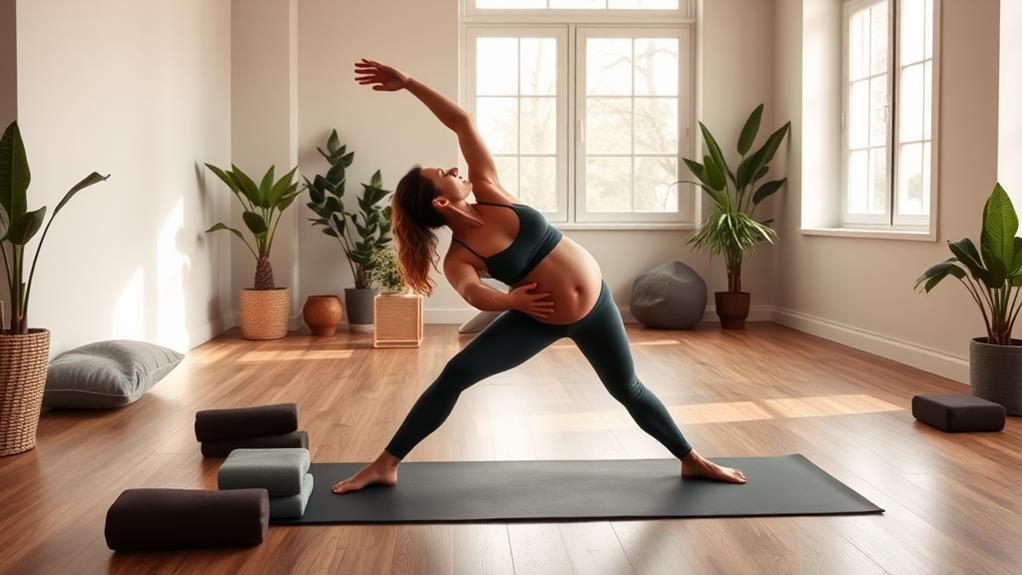
If you're practicing yoga during pregnancy, it's important to be mindful of your body and the poses you choose. One pose you might want to avoid is Chaturanga Dandasana, or Four-Limbed Staff Pose. As your belly grows, this pose can put too much strain on your abdomen and pelvic floor.
Instead of pushing through it, consider modified poses like kneeling push-ups or practicing on blocks. These can help you avoid discomfort and keep you stable.
As your pregnancy progresses, your center of gravity shifts, making it easier to lose your balance in poses like Chaturanga. It's safer to transition directly into Downward-Facing Dog from Plank Pose. This way, you can still enjoy a strong practice without the risks.
Always remember, it's best to consult a qualified prenatal yoga instructor. They can give you personalized advice on how to modify poses and ensure you have a supportive practice.
Your safety and comfort are the top priorities, so listen to your body and make adjustments as needed. Happy practicing!
Twisted Chair
Twisted Chair Pose, or Utkatasana with a twist, may seem like a great way to strengthen your legs and core, but it can actually pose risks during pregnancy. This pose involves a deep twist that can compress the abdomen and restrict space for your growing baby, making it unsafe during this special time.
As your body changes, those deep twists can lead to overstretching and increase the risk of injury, especially with the relaxation of ligaments due to hormonal changes. That's why practicing Twisted Chair Pose after the first trimester is discouraged.
Instead, you should seek modified poses that allow for gentle stretching without any discomfort. Regular Chair Pose, for example, can provide a safe alternative without the twist.
It's always a good idea to consult with a certified prenatal yoga instructor. They can offer safer alternatives and help ensure you're practicing with proper alignment.
Remember, staying safe during pregnancy is your top priority, and there are plenty of modified poses that'll keep you strong and healthy without the risks associated with Twisted Chair Pose!
Revolved Side Angle
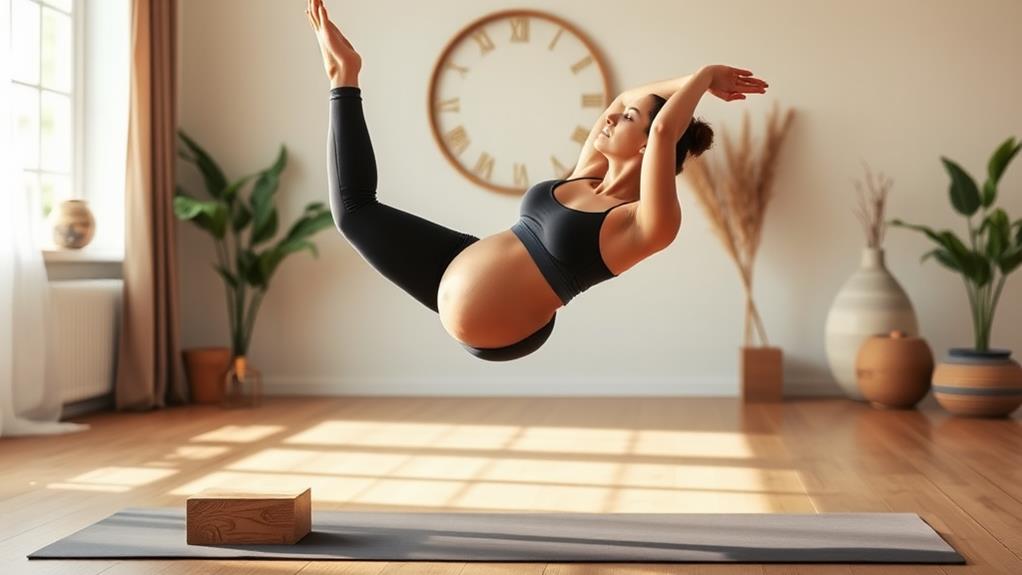
Revolved Side Angle Pose, or Parivrtta Parsvakonasana, also carries similar risks as the Twisted Chair Pose during pregnancy. This pose compresses the abdomen, which isn't ideal for your growing baby.
Plus, with those hormonal changes, you might find your ligaments a bit looser, leading to an increased risk of injury. Deep twists like this one can also create discomfort and strain in your lower back—yikes!
Instead of diving into the Revolved Side Angle Pose, consider trying safe alternatives. The regular Side Angle Pose (Utthita Parsvakonasana) is a great choice, as it opens up your body without any pressure on your belly.
Gentle open twists can be fun too! They let you stretch and breathe without causing any trouble.
Always remember to chat with a certified prenatal yoga instructor. They can help you find the best modifications and practices to keep you safe and strong during your pregnancy.
Bow Pose
While Bow Pose (Dhanurasana) may seem like a great way to stretch and strengthen your body, it's best to avoid it during pregnancy. This pose involves lying on your stomach and lifting your legs and chest, which can increase abdominal pressure and strain your lower back. Not exactly what you need when you're expecting!
Practicing Bow Pose after the first trimester could lead to discomfort and potential complications. It can compress the uterus and affect blood flow, which isn't ideal for you or your little one. Yikes!
Instead of Bow Pose, consider safe yoga poses like Camel Pose (Ustrasana). This heart-opening move allows you to stretch without lying on your stomach, keeping you and your baby happy.
Joining prenatal yoga classes with certified instructors can also help you find safer modifications and poses that are perfect for your journey.
Full Wheel
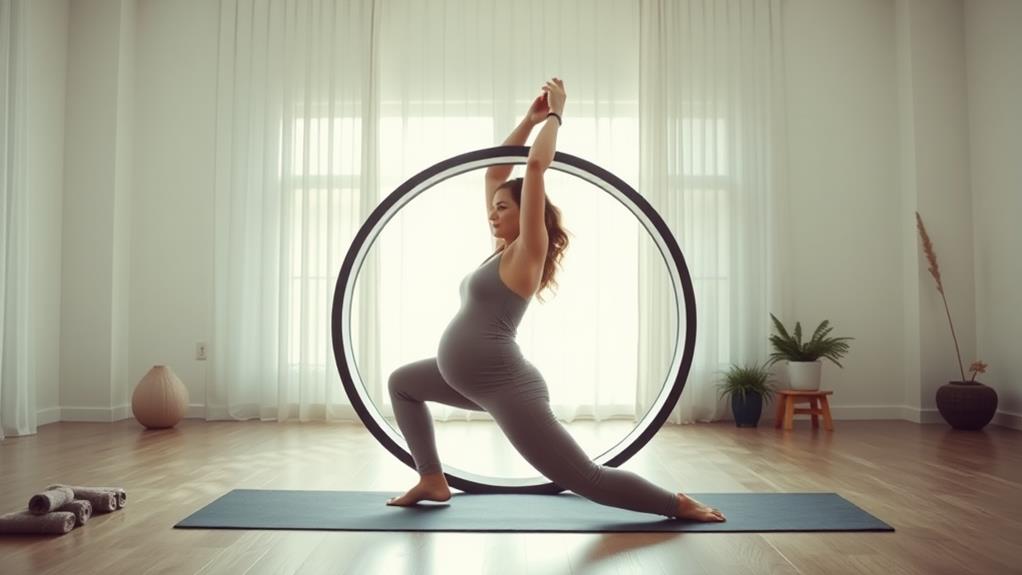
Full Wheel Pose (Chakrasana) is one you should steer clear of during pregnancy, particularly after the first trimester. This pose can put a lot of strain on your abdominal cavity and spine, which isn't great news for pregnant women.
As your belly grows, practicing Full Wheel can increase abdominal pressure and discomfort. Yikes!
The significant backbend required in this pose might make lower back pain even worse, something many expecting moms already deal with. Plus, with all those hormonal changes, your ligaments are getting a bit lax, making overstretching a real risk. We definitely don't want you getting hurt!
But don't worry, there are safer alternatives to Full Wheel Pose! One fantastic option is Bridge Pose (Setu Bandhasana).
This pose offers heart-opening stretches without the added stress on your abdomen. It's a friendlier choice that keeps you safe while still allowing you to enjoy your practice.
Prone Poses
As your pregnancy progresses, it's crucial to be cautious with prone poses like Bow Pose and Locust Pose. These poses involve lying on your belly, which can create unwanted abdominal pressure.
As your baby grows, this pressure can lead to discomfort and even worsen lower back pain. Plus, practicing these poses might increase your risk of diastasis recti, a condition where the abdominal muscles separate. Yikes!
Instead of subjecting yourself to the discomfort of prone poses, consider trying alternatives like camel pose. This modification offers great heart-opening benefits without the risks that come from lying on your stomach.
Remember, safety during pregnancy is super important, and it's okay to adjust your practice. Always listen to your body. If something doesn't feel right, it's probably best to skip it!
Staying comfortable and strong is what matters most. So, while Bow Pose and Locust Pose may sound fun, your growing belly deserves some TLC. Stick with poses that keep you feeling good, and you'll navigate your pregnancy like a champ!
Closed Hip Stretches
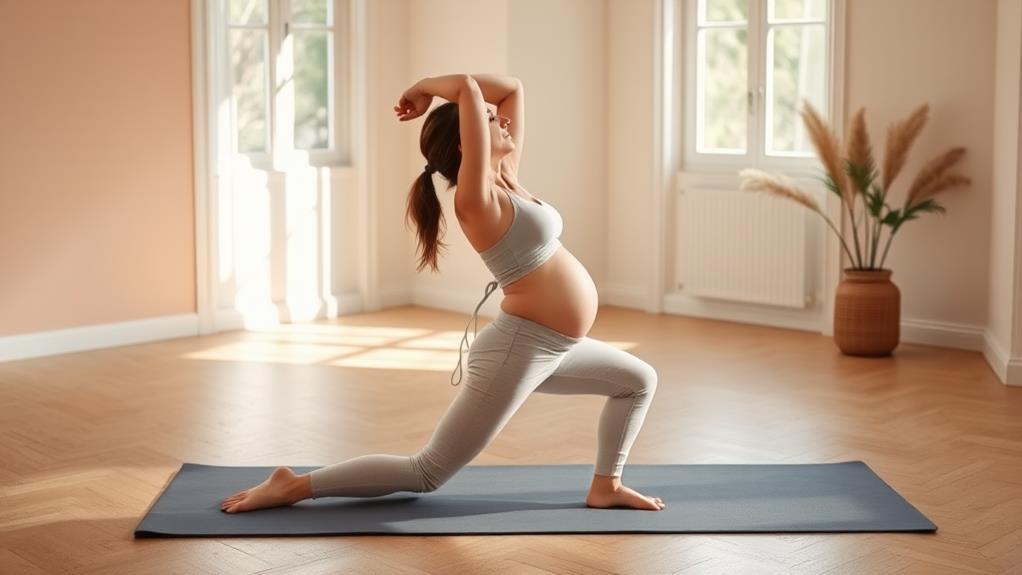
After avoiding prone poses, it's important to pay attention to closed hip stretches. These stretches, like deep seated forward folds and intense pigeon pose, can compress your abdomen and limit space for your growing baby. That's definitely not safe during pregnancy!
Not to mention, your body's hormonal changes can make your ligaments more flexible, increasing the risk of injury.
But don't worry! There are modifications you can use to keep your practice safe. Gentle open hip stretches, such as butterfly pose, are great alternatives. You can also use props for extra support.
It's all about finding what works for you!

